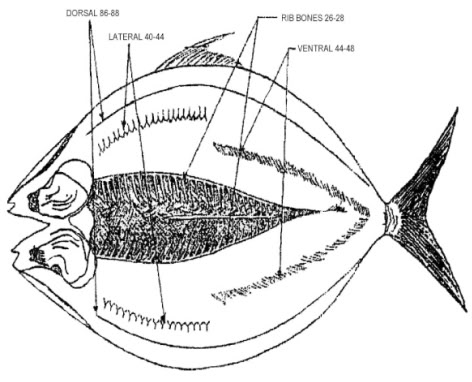‘Boneless bangus’ can be considered a uniquely Philippine product that makes deboned milkfish more acceptable to a wider range of consumers. The proper technical term is ‘deboned bangus’. Deboning would seem to be a simple process. It may be simple for most other species of fish but not for milkfish.
Deboning of Milkfish
(Guevara et al., 1973 in Espejo-Hermes, 1998.
Materials
Fresh milkfish
Tools and Utensils
Mosquito forceps
Knives
Basins
Chopping board
Utility trays
Procedure
Additional steps for washing before and after deboning (in parenthesis) comes from Kok et al, 2002.
a) (Wash fish in chilled 30 to 50 ppm chlorinated water)
b) The fish may or may not be scaled. Trim the fins. Remove the anal fin by making a small cut around the base of the large fins, then pull the fins forward to remove the fin bones and other nuisance bones.
c) Split the fish down the dorsal side. Then turn the knife flat and extend the cut from the tail to the head by running the edge of the knife along the backbone. Let the fish lay open like a butterfly fillet, then remove the gills and internal organs.
d) Lay the fish flat on its skin and hold the knife horizontally to remove the backbone.
e) Put the fish flat on a shallow tray then pull out the rib bones with the aid of forceps. Make a superficial cut slit along the dent of the dorsal muscle from the head to the tail.
f) Remove the spines on the ventral side in the same manner. Take out the filamentous y-shaped spines along the lateral line.
g) (Dip the deboned fish in chilled 1% brine to remove the excess blood)
h) Pack in plastic bag, and freeze. (Deep freezing in a blast freezer at -40°C is recommended for longer shelf life and is necessary to meet export standards).
i) Alternatively it can be sliced into different cuts (bangus belly, etc) before being packed and frozen. It may also be brined and smoked, or marinated prior to packing and freezing.

Source: (Wilfredo G. Yap, Antonio C. Villaluz, Ma. Gracia G. Soriano, and Mary Nia Santos) Milkfish Production and Processing Technologies in the Philippines

Nice…. I probably try this procedure thanks for the idea
nice
good